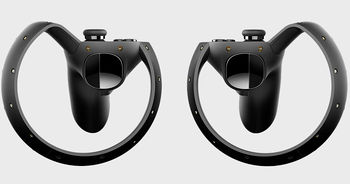Difference between revisions of "Oculus Touch"
Xinreality (talk | contribs) |
Xinreality (talk | contribs) |
||
| Line 38: | Line 38: | ||
|Website=https://www.oculus.com/en-us/rift/ | |Website=https://www.oculus.com/en-us/rift/ | ||
}} | }} | ||
| − | [[Oculus Touch]] also known as the '''Half Moon''' is the first unique [[Input Device]] for the [[Oculus Rift]]. Oculus Touch consist of 2 mirror-image controllers, 1 held in each hand. | + | [[Oculus Touch]] also known as the '''Half Moon''' is the first unique [[Input Device]] for the [[Oculus Rift]]. Oculus Touch consist of 2 mirror-image controllers, 1 held in each hand. These controllers are wireless and motion tracked by the same [[positional tracking sensor]] that tracks the [[Rift]] [[HMD]]. Oculus Touch has traditional gamepad controls such as analog stick, buttons and triggers along with the abilities to detect hand gestures and provide [[haptic feeback]]. |
Oculus Touch was revealed alongside [[Oculus Rift CV1]], on June 11, 2015 during [[Oculus VR]]'s Pre-E3 Special Live Event. | Oculus Touch was revealed alongside [[Oculus Rift CV1]], on June 11, 2015 during [[Oculus VR]]'s Pre-E3 Special Live Event. | ||
Revision as of 09:20, 27 June 2015
| Oculus Touch | |
|---|---|

| |
| Basic Info | |
| Type | Input Device, Motion Tracker |
| Subtype | Hands/Fingers Tracking, Haptics |
| Platform | Oculus Rift |
| Developer | Oculus VR |
| Release Date | First half 2016 |
| Website | https://www.oculus.com/en-us/rift/ |
| System | |
| Operating System | Windows, Mac, Linux |
| Storage | |
| Display | |
| Image | |
| Optics | |
| Tracking | |
| Tracking | 6DOF |
| Rotational Tracking | IMUs |
| Positional Tracking | External camera sensor |
| Audio | |
| Connectivity | |
| Device | |
| Input | Analog stick, 2 buttons, 2 triggers, hand gestures |
Oculus Touch was revealed alongside Oculus Rift CV1, on June 11, 2015 during Oculus VR's Pre-E3 Special Live Event.
Contents
Features
- Hand presence - the sense of your virtual hands are the same as your natural hands. Your hands are tracked with accuracy and low latency.
- Manipulation - precise manipulation of virtual objects. For example, user should be able to pick up a gun, fire it then discard it without having to think about it.
- Low mental load - instinctively interact with objects in VR. Use the controllers effortlessly like how you use your real hands in the real world.
- Communicative gestures - hand gestures are detected. Gestures such as pointing, waving and giving the thumbs up are useful for social interactions.
- Transitional inputs - gamepad inputs such as analog stick, buttons and triggers. These time-tested input methods allow traditional gaming experiences to fuse with new VR experiences.
- Lightweight - lightweight and ergonomic, easy to get into and out of. The controller has to be comfortable for long periods of usage.
Hardware
Traditional Controls
One wireless Oculus Touch is held in each hand. 2 Oculus Touch controllers are designed to operate simultaneously. Some of the controller's features are similar to that of a traditional gamepad. It has 1 analog stick and 2 buttons on top and 2 triggers, 1 for the index finger located in front and 1 for the middle finger on the side.
Tracking
Oculus Touch achieves accurate, low latency, 6DOF tracking through the same system as the Rift headset. IR LEDs are placed on the controllers' bodies and rings, allowing them to be tracked by the same positional tracking sensor that tracks the HMD. The LEDs on the outer rings prevent occlusion caused by your hands. In addition to positional tracking, controllers possess built-in IMUs that allow rotational tracking.
Gesture Sensing
The device has an inward facing sensor matrix and additional sensors that keep track of your fingers and detect hand gestures.
Ergonomics
You grip the controller similar to how you shake someone's hand. Your thumb is placed on top of the controller and handles the analog stick and 2 buttons. Your index finger is placed in front and is responsible for a trigger there. Your other 3 fingers grip the handle of the controller with your middle finger responsible for a trigger on the side.
When you hold the controller, your hand is in a comfortable natural resting position. When you grab something or pick something up in VR, you activate the side trigger with your middle finger and grip of your hand becomes tighter. It simulates the natural motion of grasping an object in real life.
Apps
Developer
History
Oculus Touch's codename while in development was Half Moon.